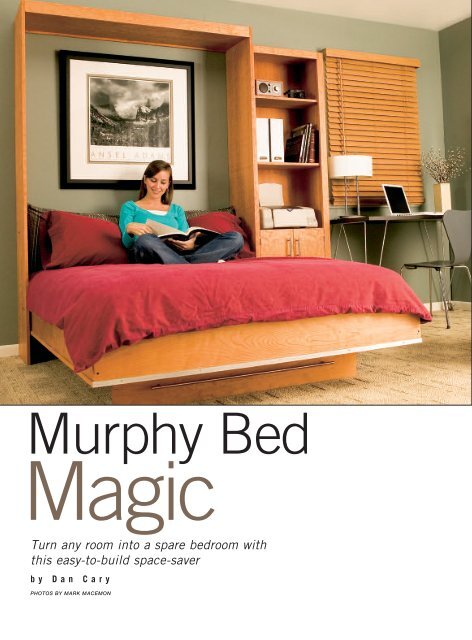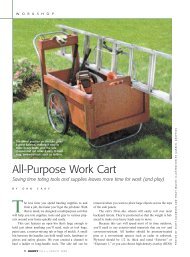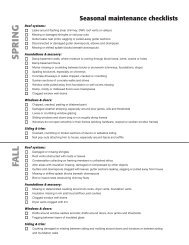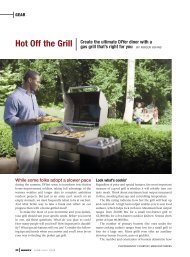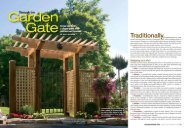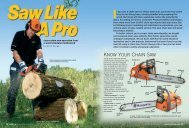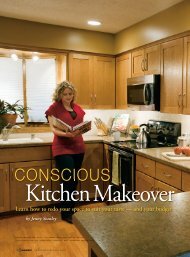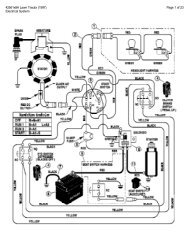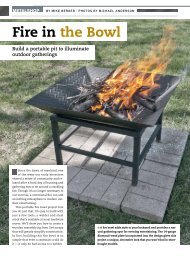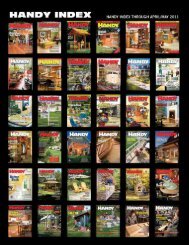Murphy Bed - Handyman Club of America
Murphy Bed - Handyman Club of America
Murphy Bed - Handyman Club of America
Create successful ePaper yourself
Turn your PDF publications into a flip-book with our unique Google optimized e-Paper software.
<strong>Murphy</strong> <strong>Bed</strong><br />
Magic<br />
Turn any room into a spare bedroom with<br />
this easy-to-build space-saver<br />
b y D a n C a r y<br />
PHOTOS BY MARK MACEMON
Now you see it; now you don’t. Liftmechanism<br />
hardware makes opening<br />
and closing this modern murphy bed<br />
easy for anyone.<br />
Like many homeowners, I converted a small bedroom into a home <strong>of</strong>fice. It’s a<br />
trade-<strong>of</strong>f that makes sense, except when we have visitors and must give up<br />
our bed. We considered buying a s<strong>of</strong>a bed, but we’ve never liked sleeping on<br />
them, and our current s<strong>of</strong>as don’t need replacing.<br />
In my search for a new and better alternative I found a solution that isn’t new at<br />
all — a murphy bed. It’s an ingenious piece <strong>of</strong> furniture that combines the comfort<br />
<strong>of</strong> a standard mattress with the appearance <strong>of</strong> a closet or cabinet that is less than 18<br />
in. deep. You can customize most designs to fit your home’s décor, adding trim,<br />
matching bookcases or even built-in lighting (see “Design Options,” p. 35).<br />
The bed’s name is attributed to William L. <strong>Murphy</strong>, who designed and patented<br />
the original <strong>Murphy</strong> <strong>Bed</strong> in San Francisco around 1900. His company, The<br />
<strong>Murphy</strong> <strong>Bed</strong> Co., and several others continue to manufacture and sell murphy
BUILDING A MURPHY BED<br />
Side rails<br />
Lower ballstud<br />
plate<br />
Depth<br />
gauge<br />
Pivot<br />
plate<br />
1<br />
Assemble the inner bed frame<br />
with frame struts (inset) made with solid wood 1x2s.<br />
Plywood bed rails and panels will conceal this frame.<br />
2<br />
Fasten the lift-mechanism hardware to the side rails and<br />
vertical side panels and then remove the hardware before<br />
applying finish to the pieces.<br />
Face<br />
panel<br />
Leg<br />
6 7<br />
Fasten the three locking hinges to the<br />
leg with No. 6 x 3/4-in. panhead<br />
wood screws.<br />
beds today (see SOURCES ONLINE).<br />
Several <strong>of</strong> these companies have<br />
designed their own lift systems, some<br />
adopting the murphy bed name and<br />
others simply calling their products<br />
wall beds.<br />
Even though they’ve been around for<br />
more than a century, murphy beds aren’t<br />
common in today’s homes. You won’t<br />
find them in most furniture showrooms,<br />
and many people incorrectly assume that<br />
installation requires cutting into a wall.<br />
Although early versions were built into<br />
apartment walls and concealed with<br />
closet doors, today most murphy beds are<br />
placed in the room like a large piece <strong>of</strong><br />
furniture. Besides greater installation<br />
flexibility, modern murphy beds also<br />
have improved lift mechanisms, so you<br />
don’t have to worry about being gobbled<br />
up into the wall like the comedians in old<br />
slapstick movies.<br />
There are three basic requirements<br />
Fasten the locking hinges, already attached to the leg, to the<br />
inner frame strut. The top <strong>of</strong> the leg must be flush against the<br />
face panel (inset).<br />
to consider before buying or building<br />
a murphy bed. First, you need at least<br />
4 ft. <strong>of</strong> open wall space for a twin bed<br />
and more for a larger bed or if you<br />
intend to connect a bookcase. Second,<br />
you need 7 ft. <strong>of</strong> clearable space (with<br />
easy-to-move furniture) in front <strong>of</strong> the<br />
bed for it to open. Finally, you must<br />
have an egress window (a window large<br />
enough for a person to climb through)<br />
in any room that will be used for sleeping.<br />
Check with your local building<br />
inspections department for minimum<br />
egress requirements.<br />
<strong>Murphy</strong> bed construction<br />
Whether you choose to call them murphy<br />
beds or wall beds, they feature three key<br />
components: the lift mechanism, the bed<br />
frame and the cabinet. There are two<br />
main types <strong>of</strong> lift mechanisms: spring<br />
and piston. Both systems operate under a<br />
similar principle — they create force that<br />
helps lift the bed into the closed position<br />
(see “How a <strong>Murphy</strong> <strong>Bed</strong> Works,” p. 37).<br />
The force is balanced so that the<br />
weight <strong>of</strong> the bed frame and mattress<br />
together is enough to hold the bed down<br />
on the floor. Some spring systems feature<br />
adjustable tension, but piston systems<br />
are typically not adjustable.<br />
Different piston strengths are matched to<br />
the style and size <strong>of</strong> bed you are building.<br />
The variable is the mattress weight.<br />
If the mattress that you are using with a<br />
nonadjustable piston or spring system is<br />
too light, the bed will rise slightly or<br />
float <strong>of</strong>f the floor. In this case, you must<br />
add a small amount <strong>of</strong> weight under the<br />
mattress to keep it grounded.<br />
The bed frame holds the mattress.<br />
Because the bed frame must fit into<br />
the cabinet, thickness is an issue. A<br />
typical installation does not contain a<br />
box spring, and the mattress cannot be<br />
more than 12 in. thick.
Attach 5-1/2-in. strips<br />
to the second panel<br />
First panel<br />
Three bottom<br />
panels<br />
No. 6 x 3/4-in.<br />
wood screws<br />
3 4 5<br />
Reattach the lift-mechanism hardware<br />
to the side rails and then attach the<br />
head, foot and side rails to the inner<br />
frame with 1-1/4-in. wood screws.<br />
Fasten the aluminum strips to the<br />
bottom edge <strong>of</strong> the four bottom face<br />
panels and to the top and bottom<br />
edges <strong>of</strong> the top panel.<br />
Position the face panels facedown.<br />
Apply glue to the bed frame struts,<br />
and fasten the frame assembly to the<br />
face panels with 1-1/4-in. screws.<br />
Cabinet sides<br />
Wood screws<br />
Pivot rod<br />
plate<br />
Upper ballstud<br />
plate<br />
Mattress<br />
strap<br />
8 9<br />
T-nuts<br />
Machine<br />
screws<br />
Install the 1/4-in. plywood mattress<br />
panels over the inner frame. Drive 1-in.<br />
screws to secure the elastic straps<br />
that will hold the mattress in place.<br />
Design options<br />
<strong>Murphy</strong> beds can be designed to complement any home’s décor, and<br />
you can install a mattress as large as queen size in either the vertical<br />
or horizontal position. The strength <strong>of</strong> the lift mechanism required<br />
depends on the configuration that you choose. — DC<br />
Reattach the lift-mechanism hardware to the cabinet sides before installing<br />
the bed. Fasten the pivot rod plates and upper ball-stud plates with wood<br />
screws, machine screws and T-nuts.<br />
Vertical<br />
configuration<br />
Horizontal<br />
configuration
Plastic<br />
washer<br />
Pivot rod plate<br />
E-clip<br />
10<br />
Pivot<br />
plate<br />
Insert the pivot rod on the cabinet side into<br />
the pivot plate <strong>of</strong> the side rail. Secure the<br />
pivot hardware with an E-clip (inset).<br />
11<br />
Tilt the cabinet side panels upright,<br />
and attach the headboard with 2-in.<br />
screws and the cabinet header assembly<br />
with 1-1/4-in. screws. No glue is<br />
used to assemble the cabinet, making<br />
it simple to disassemble and move.<br />
Stud<br />
loca-<br />
12<br />
Keeping the cabinet a couple <strong>of</strong> feet from<br />
the wall, connect the piston to the lower and<br />
then upper ball-stud plates. The bed is tilted<br />
a few inches beyond vertical to make the<br />
upper connection. Safety note: Do not operate<br />
the bed until it is secured to the wall.<br />
13<br />
Drive 3-in. coarse-thread screws through the header and into wall<br />
studs. Secure a full-size bed to at least three stud locations.<br />
Spring systems <strong>of</strong>ten incorporate a<br />
metal bed frame. These systems are<br />
usually fastened to the floor, and the<br />
cabinet is a freestanding box built<br />
around the bed frame. Piston systems<br />
use a wood bed frame that is connected<br />
to the cabinet by pivots, and the cabinet<br />
is fastened to the wall.<br />
Most murphy bed manufacturers<br />
do not require pr<strong>of</strong>essional installers;<br />
in fact, they encourage DIY construction.<br />
Product options range from basic<br />
lift-mechanism kits, which cost $250 to<br />
$300 and require you to build the bed<br />
frame and cabinet from scratch, to<br />
complete ready-to-install beds that<br />
cost several thousand dollars.<br />
I chose to use a piston-mechanism<br />
kit manufactured by Create-A-<strong>Bed</strong> Inc.<br />
<strong>of</strong> Louisville, Kentucky. The kit costs<br />
$279 and includes all necessary<br />
mechanical hardware, building plans for<br />
a bed and bookcase and a videotape that<br />
demonstrates the construction process<br />
and building techniques.<br />
One <strong>of</strong> the benefits <strong>of</strong> this bed system<br />
is that you don’t need many tools to<br />
build it. You will need basic hand tools<br />
(a tape measure, a hammer, clamps,<br />
etc.), a table saw or circular saw<br />
equipped with a sharp plywood-cutting<br />
blade and a drill/driver. A miter saw is<br />
helpful for cutting pieces to length, but<br />
it’s not required.<br />
Materials<br />
The bed in the Create-A-<strong>Bed</strong> design is<br />
built from a combination <strong>of</strong> solid stock<br />
and veneer-core plywood or particleboard
How a murphy bed works<br />
A murphy bed closes with the assistance<br />
<strong>of</strong> a spring or piston mechanism. The bed<br />
I built uses a piston system. The piston is<br />
compressed when the bed is open (left).<br />
When the bed is closed the piston<br />
extends, exerting force to help lift the<br />
weight <strong>of</strong> the bed. — DC<br />
ILLUSTRATION BY MARIO FERRO<br />
Upper ball-stud plate<br />
Compressed piston<br />
Lower ball-stud plate<br />
Pivot<br />
Direction <strong>of</strong><br />
piston force<br />
material, such as melamine. Different<br />
building plans are provided depending on<br />
the combination <strong>of</strong> material, bed size and<br />
orientation that you choose.<br />
I built a full-size vertical bed with<br />
one 24-in.-wide bookcase using cherry<br />
plywood and solid cherry. It required<br />
five sheets <strong>of</strong> 3/4-in. cherry plywood,<br />
one sheet <strong>of</strong> 1/4-in. cherry plywood,<br />
two sheets <strong>of</strong> 1/4-in. birch plywood,<br />
about 24 lineal ft. <strong>of</strong> 1x4 solid cherry<br />
and 14 pieces <strong>of</strong> 1x2 x 8-ft. solid poplar.<br />
Create-A-<strong>Bed</strong>’s cabinet is designed<br />
to look like a closet with bifold doors,<br />
but I wanted to create a more modern<br />
style. With the approval <strong>of</strong> the manufacturer’s<br />
technical advisor, I modified the<br />
front panel and leg to suit my taste (see<br />
“Our Design Modifications,” p. 38).<br />
The change had little effect on the<br />
material requirements.<br />
Safety note: <strong>Murphy</strong> bed lift systems<br />
create strong forces on the structure. Be<br />
sure to check with the manufacturer<br />
before making any changes to the design.<br />
Anchoring a murphy bed<br />
It is critical that you properly anchor<br />
the bed cabinet to the wall. Here are<br />
the three most common wall materials<br />
that you will encounter and the<br />
correct anchor to use in each case.<br />
Most <strong>of</strong> my building time was spent<br />
cutting and finishing the large plywood<br />
pieces before assembly. I used a table<br />
saw to cut the plywood, but you could<br />
also use a circular saw with a straightedge<br />
guide.<br />
Tip: When you cut plywood with<br />
a table saw, keep the good side <strong>of</strong> the<br />
plywood faceup; when you use a circular<br />
saw, keep the good side <strong>of</strong> the plywood<br />
facedown.<br />
Cover all <strong>of</strong> the plywood edges that<br />
will be left exposed with heat-activated<br />
edge banding, which is sold in rolls (see<br />
SOURCES). Cut each strip <strong>of</strong> edge<br />
banding a couple <strong>of</strong> inches longer than<br />
the plywood edge. Press the edge banding<br />
along the plywood edge with a hot<br />
household iron. (Protect the face <strong>of</strong> the<br />
iron by covering it with aluminum foil.)<br />
While the edge banding is still hot, press<br />
it down with a roller or scrap <strong>of</strong> wood.<br />
Allow it to cool for a few minutes and<br />
then trim <strong>of</strong>f the excess with a utility<br />
knife, chisel or special edge-banding<br />
trimmer, also available where edge<br />
banding is sold.<br />
Fasten the bed hardware and then<br />
remove it before sanding and applying<br />
the finish. The manufacturer provides<br />
detailed diagrams that show where each<br />
piece <strong>of</strong> hardware is located.<br />
After sanding, I chose to apply three<br />
coats <strong>of</strong> wipe-on polyurethane finish to<br />
Building the bed<br />
The construction process is not difficult<br />
(see how-to photos beginning on p. 34).<br />
The biggest obstacle for many people<br />
will be finding enough space to work.<br />
You need a large, flat work surface —<br />
a full sheet <strong>of</strong> plywood is just the right<br />
size. The finished bed is large, so if you<br />
have a narrow hallway or stairway to<br />
contend with, consider machining and<br />
finishing the parts in your shop or<br />
garage and assembling the bed in its<br />
designated room.<br />
Stud: 3-in. coarse-thread screws<br />
Masonry: 3/16 x 2-in. masonry<br />
anchors<br />
Metal stud: 3/16 x 4-in. toggles
Our design modifications<br />
The murphy bed shown in the photos<br />
required several changes and additions<br />
to the Create-A-<strong>Bed</strong> plan provided<br />
with the kit:<br />
Inner <strong>Bed</strong> Frame<br />
Reposition and add frame struts to<br />
provide support behind the horizontal<br />
face-panel seams (see drawing below).<br />
Face-Panel Hinge Openings<br />
The leg hinges fit through notches cut<br />
through the second face panel from<br />
the top. Cut three 2-1/4-in.-wide x<br />
3-in.-long notches through the top<br />
edge <strong>of</strong> the panel. Locate the outside<br />
notches 5-7/8 in. from each<br />
<strong>Bed</strong> frame<br />
17-1/2"<br />
16"<br />
side, and center the middle notch<br />
along the top edge.<br />
Aluminum Accents<br />
Aluminum strips are attached between<br />
the face panels as a decorative accent.<br />
You can purchase aluminum at a metalworking<br />
or metal supply shop. When<br />
we bought aluminum, the supplier cut<br />
it to length, and we drilled countersinks<br />
and pilot holes through each strip for<br />
No. 6 screws.<br />
Tip: Use a carbon steel drill bit to<br />
bore through aluminum. To cut aluminum,<br />
use carbide-tip saw blades<br />
designated for nonferrous metals (metals<br />
that don’t contain iron).<br />
16"<br />
14-1/4"<br />
4"<br />
12"<br />
Support Leg<br />
Two small legs are replaced with one<br />
long leg. Use 7-in.-wide stock, or glue<br />
together pieces <strong>of</strong> 3/4-in. solid stock<br />
to create the 7 x 45-in. leg.<br />
Cutting List Changes<br />
<strong>Bed</strong> face panels, veneer-core plywood<br />
Top face panel . . . . 3/4 x 11-13/16 x 56 in. (1)<br />
Face panels . . . . . . 3/4 x 15-7/8 x 56 in. (4)<br />
Aluminum strips . . . 3/16 x 3/4 x 56 in. (5)<br />
Aluminum strips . . . 3/16 x 3/4 x 5-1/2 in. (2)<br />
Leg, solid wood . . . 3/4 x 7 x 45 in. (1)<br />
Additional Materials<br />
3/4 x 1-1/2-in. x 8-ft. solid frame stock (2)<br />
25 lineal ft. <strong>of</strong> 3/16 x 3/4-in. aluminum<br />
30-in. cabinet pull (see SOURCES)<br />
11-1/4"<br />
12"<br />
ILLUSTRATION BY MARIO FERRO<br />
all <strong>of</strong> the panels before assembling them<br />
because it is easier to work on the flat<br />
panels individually. Mask over or leave<br />
unfinished any areas where glue will<br />
be applied, such as along the bottom<br />
1-1/2 in. <strong>of</strong> each rail and the inside faces<br />
<strong>of</strong> the face panels.<br />
After the finish is dry, reattach the<br />
hardware and begin assembling the bed.<br />
The bed frame and rails are joined with<br />
simple butt joints fastened with glue and<br />
wood screws or finish nails. Drill countersinks<br />
and pilot holes for each screw.<br />
The last step before installing the bed is<br />
to attach the face panels to the frame<br />
and rail assembly.<br />
Installation<br />
Installing the bed and cabinet are probably<br />
the easiest parts <strong>of</strong> the project, but<br />
they are also the most important for<br />
ensuring safe operation.<br />
Finish assembling the cabinet and<br />
bed frame a couple <strong>of</strong> feet away from<br />
the wall. Connect the pivot hardware<br />
attaching the headboard and cabinet top<br />
with wood screws.<br />
Connecting the pistons to the ballstud<br />
plates is the final step before<br />
securing the cabinet to the wall. The<br />
piston is labeled to show the correct<br />
installation orientation. Close the bed a<br />
few inches beyond vertical to snap the<br />
piston onto the ball-stud plates. If the<br />
piston does not fit, double-check the<br />
ball-stud and pivot-hardware locations<br />
and adjust them if necessary.<br />
The cabinet must be properly fastened<br />
to the wall for safe operation.<br />
When a murphy bed is in the open position,<br />
the lift mechanism is storing the<br />
energy that will be used to help lift the<br />
bed. If the cabinet is not properly<br />
secured, the lift mechanism could pull the<br />
cabinet away from the wall and down on<br />
top <strong>of</strong> the bed.<br />
Use the appropriate type and number<br />
<strong>of</strong> fasteners for the size <strong>of</strong> bed you are<br />
installing and for the room’s wall framing<br />
(see “Anchoring a <strong>Murphy</strong> <strong>Bed</strong>,” p. 37).<br />
Drive one fastener into each stud located<br />
behind the bed, or drive masonry anchors<br />
at 16-in. intervals in masonry walls. Use<br />
three anchors for a twin or full-size bed<br />
and four for a queen-size bed.<br />
Once the bed is secured to the wall,<br />
it is ready for the mattress. The bed<br />
frame will be a little difficult to pull<br />
down without the mattress. Get a helper<br />
to assist you in holding the bed frame<br />
down and placing the mattress. If the bed<br />
floats above the floor, more weight is<br />
needed under the mattress. A simple<br />
solution is to fasten a 2 x 4-ft. scrap <strong>of</strong><br />
3/4-in. medium-density fiberboard to<br />
the plywood panels under the mattress<br />
with 1-1/4-in. screws. Once the bed<br />
frame stays down on the floor, the bed<br />
is ready for use. u<br />
For online information, go to www.<strong>Handyman</strong><strong>Club</strong>.com<br />
and click on SOURCES ONLINE.<br />
<strong>Murphy</strong> bed mechanism<br />
and cabinet manufacturers:<br />
Create-A-<strong>Bed</strong>, 877-966-3852<br />
<strong>Murphy</strong> <strong>Bed</strong> Co. Inc., 800-845-2337<br />
<strong>Murphy</strong> <strong>Bed</strong> Products, 888-730-3003<br />
1-800 Wallbeds, 800-925-5233<br />
Woodworker’s Hardware (edge banding and<br />
cabinet pull No. A19019), 800-383-0130


